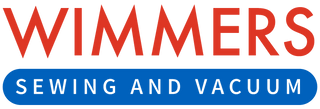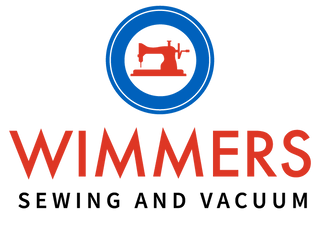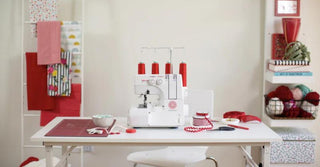National Serger Month is here, and it's time to celebrate the invaluable role of the serger in creating professional-looking garments and crafts. Whether you're a newbie to serging or a seasoned user, Wimmers Sewing and Vacuum is here to help you celebrate this occasion with our top serger picks.
Click to jump to section:
- What is a Serger?
- Wimmers' Top Serger Picks
- Benefits of Using a Serger
- How to Use a Serger Machine
- Solving Your Serging Challenges
- Sales and Repairs
- Facts About Serger Machine
- Frequently Asked Questions About Serger Machines
Unraveling the Serging Mystery: What is a Serger?
The Basics: Defining a Serger
So, what is a serger? A serger, also known as an overlock machine, is a specialized sewing machine. It's designed to seam or overcast the edge of one or two pieces of cloth for edging, hemming, or seaming. It stands out from traditional sewing machines due to its ability to cut the edges of the cloth as they are fed through, a feature that's handy for edging, trimming and seaming.
The Functionality: What Does a Serger Do?
A serger sewing machine does more than just stitch. It trims the seam and encloses the seam allowance or edge of the fabric, inside a thread casing, all in one step. The result is a professional finish that prevents the material from fraying.
The Applications: What is a Serger Used For?
Serger sewing machines are typically used for edging, hemming, and seaming. However, they offer far more versatility. They can also be used for decorative purposes, like creating ruffles or rolled hems.
In conclusion, a serger is your go-to machine for creating clean, professional, and durable seams, especially on stretchy or fraying fabrics. It's an addition to your sewing arsenal that opens up a world of possibilities.
Wimmers' Top Serger Picks: Celebrate with the Best
Babylock Serger: Your Go-To Machine
Known for their efficient and user-friendly features, the Babylock serger has an automatic threading system that makes it a breeze to thread. It offers excellent stitch quality and is perfect for both beginners and experienced users.
Singer Serger: The Versatile Artisan
Offering a variety of stitch options and adjustable stitch length and width, the Singer serger brings versatility to your sewing projects. Create ruffles, decorative edges, or even sew a seam and finish edge in one step.
Husqvarna Serger: The Premium Choice
With its robust design, reliable performance, and host of features, the Husqvarna serger is a high-end option perfect for seasoned sewers looking to take their projects to the next level.
Pfaff Serger: The Innovative Performer
Pfaff sergers are renowned for their innovative features, striking the perfect balance between advanced technology and simplicity. Offering an array of stitch options, these sergers bring out the best in your sewing projects, making it a popular choice among creative enthusiasts.
Reaping the Rewards: The Benefits of Using a Serger
Speed and Efficiency: Time-Saving Performance
One of the key benefits of a serger is its speed. Sergers are significantly faster than traditional sewing machines, allowing you to complete projects in a fraction of the time. Furthermore, sergers finish seams and trim excess fabric in one pass, saving even more time and enhancing efficiency.
Professional Finishing: Elevating Your Projects
Sergers create clean, professional finishes that you often see on store-bought garments. They lock the edges of the fabric, preventing fraying and providing a durable, high-quality finish.
Versatility: More Than Just Seams
Though famously used for seams, sergers are incredibly versatile. They can create decorative edges, rolled hems, and even gather fabric – expanding your creative possibilities.
Handling Difficult Fabrics: Effortless Management
Stretchy, slippery, or knitted fabrics can be challenging to work with on standard sewing machines. Sergers excel at handling such materials with ease, making them indispensable for sewing swimwear, activewear, or knitwear.
Embracing the advantages of a serger opens up a world of creative possibilities. A serger is a worthwhile investment for anyone serious about sewing, bringing speed, professional finishes, versatility, and ease of handling difficult fabrics to your creative repertoire. And remember, the journey with a serger doesn't end here; it's merely the beginning of a more efficient, professional, and diverse sewing experience.
Mastering the Art: How to Use a Serger Machine
Understanding the Basics: Getting to Know Your Serger
The first step in using a serger machine is understanding its components. Familiarize yourself with parts like needles, loopers, tension discs, and differential feed. Each plays a unique role in the serging process.
Threading the Serger: Putting the Pieces Together
Threading a serger can be a complex process, as it generally involves multiple threads. Most machines have a threading guide on the machine. Follow it carefully to ensure proper threading.
Adjusting the Tension: The Key to Perfect Stitches
Each thread on a serger has its own tension control. Adjusting these allows you to create balanced, neat stitches. Remember, perfect tension settings vary depending on the fabric and the type of stitch.
Practicing Different Stitches: Experiment and Learn
Sergers can create a variety of stitches, including overlock, rolled hem, and flatlock stitches. Practice each to understand how they work. Adjusting settings like stitch length, cutting width, and differential feed will affect how these stitches look and perform.
Regular Maintenance: Keeping Your Serger in Top Shape
Regular cleaning and oiling will ensure your serger functions at its best. Also, remember to change needles frequently to maintain stitch quality.
Embracing a serger machine's capabilities might seem daunting initially, but with practice and patience, it becomes an exciting tool that radically enhances your sewing projects. Take it one stitch at a time, and soon you'll be serging like a pro.

Wimmers to the Rescue: Solving Your Serging Challenges
Are you dealing with thread issues or tension problems? At Wimmers, we understand these common pain points and offer expert solutions. Our service team can promptly help with any repair needs, ensuring your serger continues to deliver the best results.
Wimmers' Value Addition: More than Sales and Repairs
Beyond offering serger sales and repairs, we at Wimmers believe in giving personalized service and adding value to your serging journey. Be it helpful advice on selecting the best serger or offering free estimates on repairs, we're always ready to assist.
Celebrate Serging with Wimmers
As we celebrate National Serger Month, let us remember the versatility and creativity sergers bring to the sewing world. With the right serger, you can open a new world of possibilities in your sewing projects.
Facts About Serger Machines
- Sergers, or overlock machines, use multiple threads to seam fabric and cover raw edges in one step.
- They are versatile, used for constructing or finishing items like t-shirt hems.
- Sergers work fast, cutting, sewing, and finishing simultaneously.
- They handle various fabric types and weights, ensuring wave-free and pucker-free seams.
- Threading, although often seen as complex, can be mastered with practice and guidance from manuals or online tutorials.
- Familiarize yourself with serger-specific terms like "upper and lower looper," "aerial," "tension disc," and "differential feed settings."
- Tension adjustments are needed depending on fabric type and thickness.
- Keeping a record of settings for different fabrics can be beneficial.
- Sergers operate at high speeds, offering versatility with various stitches used for decoration, reinforcement, or construction.
- Sergers deliver professional, durable seams and hems, handling fabrics from jersey to woven with ease.
- With a serger, your creative possibilities are endless.
Frequently Asked Questions About Serger Machines
What is the difference between a serger and an overlocker machine?
A serger typically trims the fabric edges and over seams simultaneously. When we mention "overlocker," we typically refer to the specific stitch types it creates. However, when discussing a "serger," we emphasize its ability to serge or bind fabric edges. Some overlockers might not have a serging knife, but such instances are quite rare.
The terms "serger" and "overlocker" are often used interchangeably. In North American regions, "serger" is the more frequently used term, while in Europe, "overlocker" is more common. Regardless, both names are equally applicable.
In this context, we'll use both "serger" and "overlocker" interchangeably to denote the same type of sewing machine - one that both overlocks and trims fabric simultaneously."
How do sergers differ from regular sewing machines?
A standard sewing machine, also known as a lockstitch machine, uses two threads—one in the needle and one in the bobbin—to create stitches that lock into the fabric.
Regular sewing machines typically offer a variety of stitches, with zigzag and straight stitches being the most common. Zigzag stitches are preferred for stretchy fabrics, while straight stitches are used extensively across different sewing projects.
On the other hand, sergers lack a bobbin and instead utilize multiple loopers to craft seams. They have the unique ability to seal fabric edges or join them together, creating a durable and versatile overlock seam. This makes sergers an excellent choice for projects involving knit fabrics or upholstery. The structure of a serger seam is constructed to be both sturdy and flexible, making it a popular choice for knit fabrics.
What are the applications of a serger/overlocker?
An overlocker plays a crucial role in various sewing tasks, particularly in cleaning fabric edges on woven materials and joining pieces together when dealing with knits. The seams created by an overlocker are extremely durable and well-suited to intensive stretching.
What types of overlockers/sergers are there?
There are different types of overlockers/sergers based on the number of threads they use and the functions they perform. Here are the main categories:
2-Thread Serger: These are less common but useful for finishing lightweight fabrics. They provide a neat finish without adding bulk.
3-Thread Serger: A 3-thread serger is excellent for finishing edges, especially on stretchy fabrics like knits. It's also used for decorative edging and narrow overlock stitches.
4-Thread Serger: The 4-thread serger is popular for seaming and finishing in one step. It creates a strong seam suitable for fabrics that require durability, like those in clothing construction.
5-Thread Serger: The 5-thread serger provides the utmost strength and durability, offering a combined overlock and straight chain stitch. It's often used for seaming on heavy-weight fabrics or projects requiring robust seams.
Coverstitch Serger: A coverstitch serger is used for hemming or topstitching to give a professional-looking finish. It can use 2, 3, or 4 threads and does not include a blade to trim the fabric.
Combination Serger: A combination serger can convert from a standard serger to a cover stitch machine. It provides versatility but requires re-threading when switching between functions.
Each type of serger has its own strengths and is chosen based on the requirements of the sewing project at hand.
What should I choose - a domestic or industrial serger?
For home sewing enthusiasts or small-scale garment makers, a domestic serger suffices. It's capable of handling various projects producing professional and high-quality results.
Industrial sergers, on the other hand, are heavy-duty machines designed to work with multiple layers of thick fabrics and diverse materials such as sequins, upholstery, and denim.
An industrial serger might be a better choice if you plan to use the machine extensively across different projects and materials. Though superior in many aspects, industrial sergers represent a sizable investment.
Keep in mind that industrial sergers generally offer fewer seam options like rolled hem and specialty stitch functions. They may require additional accessories to produce different types of seams, which adds to the cost.
Space is another consideration, as industrial sergers come with a separate stand and pedals requiring additional room.
Essentially, the choice between a domestic and industrial serger depends on your specific sewing requirements, budget, and available space.
What are the steps to thread a serger?
Threading a serger can often induce frustration, but rest assured, this is a common sentiment even among seasoned sewers.
Indeed, threading a serger may initially appear complex, but as with many things, practice can make it become second nature.
Unfortunately, there's no one-size-fits-all method for threading sergers, owing to the varied designs across different brands and models. Therefore, the most efficient way to learn how to thread your specific serger is by consulting its user manual. Alternatively, you can find tutorials on platforms like YouTube, which provide visual guides specific to your serger's brand and model.
Experience Serging with Wimmers
Enjoy National Serger Month with a serger of your own. Schedule a repair, buy a serger online, or simply explore our wide range of products. Call us at 800-659-3585 to start your serging journey with Wimmers today. This month, let's celebrate serging and create masterpieces together.


